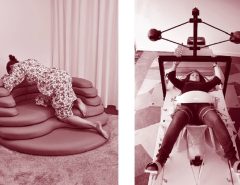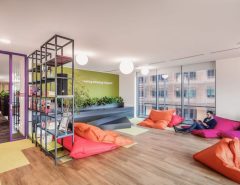Small but mighty, bungalows have become a well-loved, traditional American home. With many unique features, the bungalow has become a staple in architectural and interior design history. Born in the 1900s, the bungalow’s size allowed the development of an interior design specific to this particular style of home. Bungalow interior design is known for the eclectic interplay of both contemporary and vintage elements, the collection of artwork and artifacts, built-in features, rounded, romantic furniture, and many other defining characteristics. In this article, we take a deep dive into the history of bungalow architecture, defining bungalow features, and finally, the one-of-a-kind bungalow interior design. Keep reading to learn more.
History of Bungalow Architecture
Bungalow architecture was born in California in the most suitable climate for a home with a small porch or front patio such as those found in the California bungalow. While this home is now known for its small dimensions of anywhere from 1,500 to 1,600 square feet, its initial architecture in California was anything but small. Only once home ownership became a defining feature of the American dream did the bungalow start to take shape into the home it is today. These homes quickly spread east to the midwestern states, and by the 1950s many families were comfortably settled in the small, single-story homes known as the bungalow.
Bungalow Features
Because original bungalow homes were built in the early to mid 1900s, they were built with building codes of the time. Therefore, most bathrooms were extremely small and closet space was very limited. However, bungalows were built with the intention of encouraging families to gather. You’ll find that the bungalow’s front door opens directly into the living room, maximizing as much open space as possible within the minimal square footage. With this, the bungalow had a small number of hallways, as all rooms were fairly close to each other.
The biggest rooms within the bungalow typically are the living room and kitchen, not including the basement (if it’s a functional space). The kitchen design was built to maximize the flow of cooking and sharing meals, so they feature a clear path from fridge to counter to stove and so on. Large windows light up the living room, which sometimes features a breakfast nook in lieu of a dining area. Bungalows encouraged intimacy and closeness, so sharing meals in the living room was commonplace.
With the goal of optimizing as much space as possible, many features of the bungalow were built right into the home. For example, you’ll find Murphy beds in some of the original bungalow bedrooms. Built-in ironing boards and telephone nooks were also very common.
Characteristics of Bungalow Interior Design
Due to the space constraints, the bungalow slowly defined its own, unique interior design style. Nowadays, bungalow interior designs serve as a bookmark in history and combine both contemporary themes as well as themes original to the early to mid-20th century.
Mounted Shelves & Artwork
Traditional bungalows have low ceilings, making the walls a great backdrop for mounted shelves and artwork. The tactic here is to hang the items as high as they can go before hitting the ceiling, as this paints the illusion of taller ceilings and more space.
Use of Wallpaper
Back in the day, you could find wallpaper on every wall within the bungalow. These days, designers have traded this theme for a few walls accented with wallpaper. This adds visual appeal, while maintaining some of the bungalow’s original roots.
Rounded Furniture
The bungalow sold the idea of coziness in a warm space. The smoothed corners of rounded furniture help achieve the cozy, romantic atmosphere and complement the small space. Rounded furniture typically has a vintage influence, which you’ll see many bungalow interior designs adopt.
Global Influence
Vintage collectibles, artwork from other countries, Asian tapestries and rugs, and similar worldly artifacts often find their way into bungalow interiors. Nothing ties together the vintage undertones of bungalow furniture quite like aged artwork and trinkets from other countries or eras. This applies to furniture as well, like rugged trunks or chests that give the bungalow a air of well-traveled sophistication.
Large Rugs
Large rugs tie the whole room together, especially with some of the global artwork, vintage furniture, and other elements found within the traditional bungalow. Rugs with intricate designs can add some visual flair, as well as emphasize the comfy aura.
Sheer Curtains
Bungalows typically sport a large, front-facing window, but because bungalows are a single story, these windows can offer an unobstructed view right into your home. Curtains will not only preserve your privacy, but with the right colors, can complement the rest of your interior design. These windows bring bounds of natural sunlight, and sheer curtains will still allow that light to filter in.
Mirrors
Mirrors are a great addition to any small room, as they create an illusion of more space and reflect more natural light. Mirrors with vintage frames especially fit the overall aesthetic of bungalow interior design. Placing mirrors by the front entrance became a common practice in this interior design style.
Wooden Accents
Wooden panels made a large impression on various styles of interior design many times throughout history. Bungalow interior design is no different. Dating back to the original design styles, many contemporary, bungalow interiors showcase board and batten panels to keep this trend alive. If not the use of panels, many natural-toned, wooden accents find their way into the bungalow home.
Conclusion – What is Bungalow Interior Design?
Bungalows bookmark a pivotal moment in American history. Finding the right interior design firm is crucial for bungalow interior design. With suburbanization, owning a home became an integral part of the American dream and many families moved out of the city. Very shortly after this move, the bungalow home was born. Bungalow interior design emphasized these endearing roots. Often sporting a collection of nifty artwork, trinkets, and collectibles, this style of interior designs merged both vintage and modern elements into a shared space. With the intention of gathering loved ones, bungalow homes aimed to be cozy, yet radiant of well-traveled and intelligent tenants.




